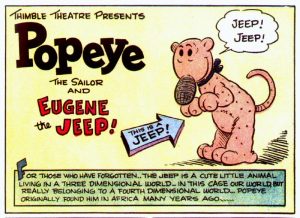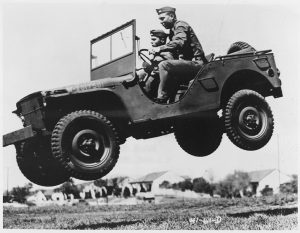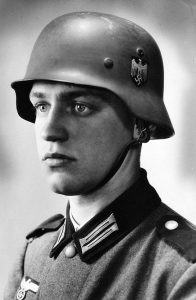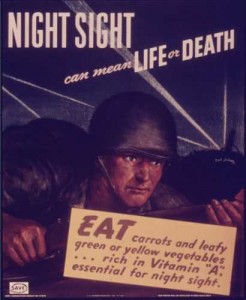Big wars always add new words to our language. All the words and terms below were invented during World War 2. During the war, every American soldier knew the meanings of all the words below. How many of them do you know?
AWOL. Acronym for Away Without Official Leave. A soldier who left his base without permission was AWOL. After a certain amount of time, he became a deserter.
Bite the Dust. Killed or wounded.
Blitzkrieg. Most people assume that the Germans invented the word Blitzkrieg, but they didn’t. The English invented this word from 2 German words: blitz (lightning) and krieg (war). Eventually, the Germans started using the word themselves.
Blockbuster. A very large bomb, usually weighing 2 tons or more, and capable of destroying or ‘busting’ an entire city block.
Brass. Officers. American officers in World War II wore brass insignias of rank.
Cash & Carry. Under Cash & Carry, a belligerent nation could buy weapons in the U.S. if they paid cash and picked them up here. England could buy tanks made in the U.S. and drive them across the Canadian border, a few miles away. Franklin Roosevelt invented the term Cash and Carry.
Chow Hound. A man who always winds up at the head of the mess line.
Dear John Letter. A letter from a wife or sweetheart saying that their relationship is over.
Duck Soup. An easy job or assignment.
Eisenhower Jacket. A short fitted belted jacket popularized by General Dwight D. Eisenhower during the war. (The blue zippered jacket that I wear is an Eisenhower jacket.)
Flat Top. An aircraft carrier.
Flying Blind. A date with a girl who you have never seen.
Get Cracking. To get something started. The term was created by RAF pilots.
G.I. An American soldier, an abbreviation for Government Issue.
Gremlins. Imaginary creatures that sabotage airplanes. The word was invented by British pilots. Any mechanical problem with an airplane was blamed on gremlins.
Haywire. An operation that went wrong or machinery that doesn’t work as it should.
Jeep. You know what a Jeep is. We don’t know who was the first person to call this vehicle a Jeep.
Joe or A Cup of Joe. Coffee. During World War 1, American soldiers called it ‘A cup of Java.’
Kamikaze. A military suicide mission.
Margarine. Imitation butter. Originally called oleomargarine.
Milk Run. An uneventful and easy bombing mission.
Molotov Cocktail. A gasoline bomb. Named after Vyacheslav Molotov, Stalin’s Foreign Minister. He encouraged Russian partisans behind German lines to make their own improvised weapons.
Pineapple. A hand grenade. American hand grenades during World War 2 were shaped somewhat like pineapples.
Pinup. A picture or poster attached to a wall of a sex symbol. The famous picture of Betty Grable, looking backwards with her hands on her hips, was the first and most famous pinup picture of the war. The word ‘pinup’ was coined by Yank magazine.
Quisling. A traitor. Named after Vidkum Quisling, a Norwegian politician who assisted the Germans in the invasion and occupation of his country.
Radar and Sonar. Radar is an acronym for Radio Assisted Detection And Ranging. Sonar stands for Sound Navigation Ranging. Radar and sonar were among the most important inventions of World War II.
Roger. Meaning ‘Message received and understood.’
Sad Sack. A sad sack is a pitiable or luckless person. This was another of the many terms coined by Yank magazine.
Section 8. A soldier sent to a psychiatric hospital or discharged from the military on grounds of insanity.
Snafu. An acronym for “Situation normal, all fouled up.” Popularized by the Private Snafu cartoons made by Warner Brothers for the U.S. Army as a training aid for soldiers.
Stinkeroo. Something of very poor quality, often used to describe bad movies.
Take Home Pay. Take home pay is what is left of your wages after tax withholding and other deductions. Income tax withholding began during World War II.




